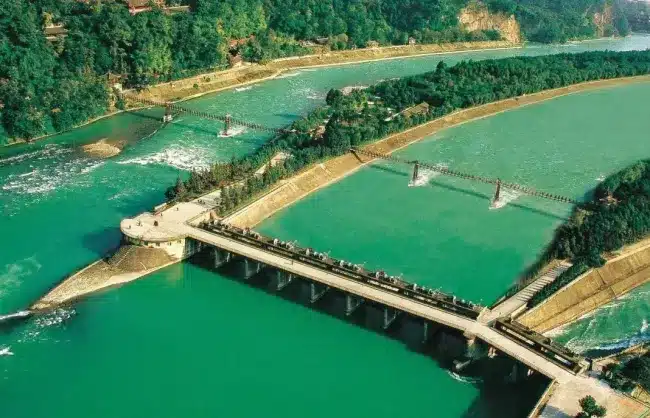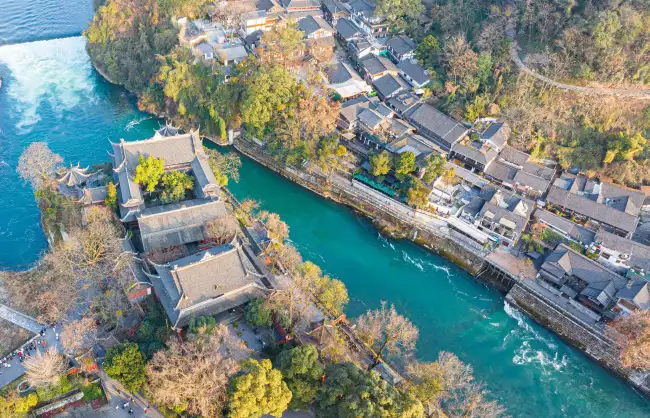Dujiangyan irrigation system, a famous ancient water conservancy project, is about 60 kilometers from Chengdu City, Sichuan province. It is said that it was founded in 256 BC by Li Bing, governor of Shu County of Qin State during the Warring States Period (476 BC-221 BC), and his son.
As one of the oldest, largest and best-maintained irrigation projects in the world, the Dujiangyan irrigation system was listed as a World Cultural Heritage site by UNESCO in January 2000. Dujiangyan irrigation system, as the only World cultural heritage with the theme of water conservancy, has been still in great use for more than 2,200 years.
Dujiangyan Irrigation System Facts
- Location: Gongyuan Road, Dujiangyan City, Chengdu City, Sichuan Province
- Ticket Price: 80 yuan/person
- Opening time: 8:00-18:00 (no entry at 17:30) from March 1 to November 30th; 8:00-17:30 (no entry at 17:00) from December 1 to February 28th
- Suggested Visiting Time: 3-4 hours

Overview of Dujiangyan Irrigation System
Chengdu Plain suffers from frequent floods and droughts due to the flooding of the Minjiang River in ancient times. Flash floods often occur in spring and summer. When the flood waters recede, tons of sand are left behind, leaving the land barren. In addition, Yulei Mountain obstructs the river flow to the east and eventually causes the problem of drought in the east and flooding in the west of Chengdu Plain.
During the Warring States Period (476 BC-221 BC), the state of Qin began to unify China. Recognizing the strategic importance of the Sichuan region in the unification of China, the emperor appointed Li Bing to build the Dujiangyan irrigation system. This project, which took nearly 10 years to complete, not only solved the flood issue but also greatly promoted the agricultural development and economic prosperity of Chengdu. Finally, it provided important material support for the cause of Qin’s unification of China.
How Does the Dujiangyan Irrigation System Work
The operation mechanism of the Dujiangyan irrigation system mainly relies on three core projects: Yuzui, Feishayan and Baopingkou. The ingenious design and cooperation of these projects enable the Dujiangyan irrigation system to effectively solve the problems of water diversion, flood discharge and sand discharge. At the same time, the Dujiangyan irrigation system ensures the agricultural irrigation and domestic water demand of Chengdu Plain and still benefits the people today.
Yuzui: It is located in the heart of the Minjiang River, dividing the Minjiang River into inner and outer rivers. The outer river is mainly used for flood discharge, and the inner river is mainly used for irrigation. The design of the Yuzui cleverly uses the terrain to realize the function of automatic water regulation.
During the dry season, 60% of the water flows into the inner river to ensure the irrigation needs of the Chengdu Plain. In the flood season, 60% of the water flows into the outer river, which not only prevents the invasion of flood disasters but also ensures agricultural water use.
Feishayan: It is located in the middle of the spillway, with the function of discharging flood water and sand. It can remove the silt and pebbles brought by the upstream to prevent the silting of the inner river. When the water in the inner river exceeds the flow limit of Baopingkou, the excess water will overflow from the Feishayan. This not only ensures the smooth flow of the inner river, but also avoids flooding.
Baopingkou: it has the function of guiding water and controlling water intake. The Baopingkou, like the mouth of the bottle, controls the amount of water entering the Chengdu plain to ensure the amount of water for agricultural irrigation.

Features of Dujiangyan Irrigation System
Water Diversion without Dams
Dujiangyan irrigation system has skillfully solved the problems of river diversion and sediment deposition by means of unique dam-free water diversion. Ancient Chinese people made full use of the river conditions and terrain characteristics to arrange engineering facilities. This not only meets the needs of irrigation or navigation, but also does not change the original characteristics of the river.
The Yuzui, the key to the Dujiangyan irrigation system, determines the proportion of Minjiang River diversion. In addition, ancient people sometimes used the “Macuo” (a three-legged wooden frame used to keep out water) to artificially change the proportion of rivers.
Embodies the Traditional Chinese View of Nature
The design concept of Chinese water conservancy projects is more inclined to how to build projects from a way of respecting and utilizing nature, rather than conquering nature. Dujiangyan irrigation system is a great example of the ancient philosophers’ natural view of “harmony between heaven and man”. Chengdu Plain has benefited from it for more than 2,000 years.
In the construction of the Dujiangyan irrigation system, the main building materials of stone, wood, and bamboo are directly derived from nature. Although the traditional materials are convenient and environmentally friendly, there are also problems like insufficient strength and poor impermeability.
In recent years, the Chinese have poured pebbles and reinforced concrete together to maintain the dam facilities. So the Dujiangyan irrigation system continues to play a role in benefiting the surrounding people.
Institutionalized Project Management and Maintenance Mechanism Prototype
Dujiangyan irrigation system can be called the best-managed ancient water project in the world. In ancient times, the Dujiangyan irrigation system already has a modern integrated management mechanism of water resources. Since the Han Dynasty (202 BC-220 AD), the imperial court-appointed officials to manage the Dujiangyan irrigation system. Chengdu Prefecture and counties in the irrigation area have full-time staff responsible for annual repair and water management.
How to Get to Dujiangyan Irrigation System from Chengdu
By shuttle bus: You can find direct buses to the Dujiangyan irrigation system scenic area from all the major attractions in Chengdu city. It is convenient for people who travel from other scenic spots to the Dujiangyan irrigation system.
By self-driving: From the Chengdu city area to the Dujiangyan irrigation system scenic area by car, will take about 1.5 hours.
By train: You can take the bullet train from Xipu Railway Station to Dujiangyan Station, then take a taxi for around 30 minutes to your destination.
Attractions nearby Dujiangyan Irrigation System
Mount Qingcheng: It is listed as a world cultural and natural heritage, and is one of the four Taoist mountains in China. You can both enjoy the natural scenery and learn about Taoist culture.
Dujiangyan Panda Base: It is a good place to see and learn about giant pandas. You can also sign up for a panda volunteer program if you’re interested.









